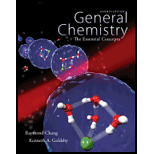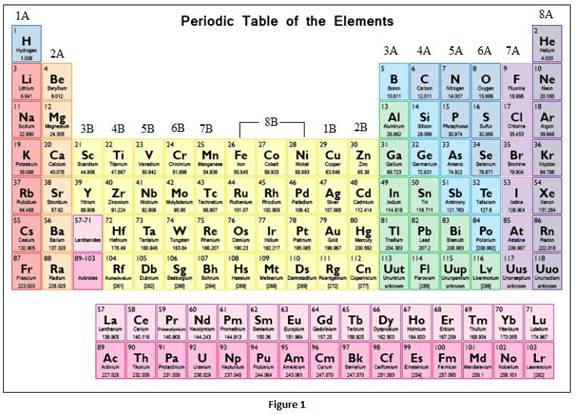
Workbook with Solutions to Accompany General Chemistry
7th Edition
ISBN: 9780077623319
Author: Raymond Chang
Publisher: MCG
expand_more
expand_more
format_list_bulleted
Question
Chapter 8, Problem 8.86QP
Interpretation Introduction
Interpretation:
The element that forms compounds with every other element in the periodic table except
Concept Introduction:
Along the period, the valence electron is added to the same shell and thus attraction by the nucleus gets stronger. Hence, ionization energy increases and reactivity decreases from left to right.
Down the group, the principal quantum number increases from to bottom and thus the size of orbital also increases which results in weak attraction by the nucleus. So reactivity increases down the group.
The periodic table is given below:

Expert Solution & Answer
Want to see the full answer?
Check out a sample textbook solution
Chapter 8 Solutions
Workbook with Solutions to Accompany General Chemistry
Ch. 8.2 - Practice Exercise An atom of a certain element has...Ch. 8.2 - Review of concepts
Identify the elements whose...Ch. 8.3 - Practice Exercise Arrange the following atoms in...Ch. 8.3 - Prob. 1RCCh. 8.3 - Prob. 2PECh. 8.3 - Prob. 2RCCh. 8.4 - Prob. 1PECh. 8.4 - Prob. 1RCCh. 8.5 - Prob. 1PECh. 8.5 - Prob. 1RC
Ch. 8.6 - Prob. 1PECh. 8.6 - Prob. 1RCCh. 8 - Prob. 8.1QPCh. 8 - Prob. 8.2QPCh. 8 - Prob. 8.3QPCh. 8 - Prob. 8.4QPCh. 8 - Prob. 8.5QPCh. 8 - Prob. 8.6QPCh. 8 - Prob. 8.7QPCh. 8 - Prob. 8.8QPCh. 8 - Prob. 8.9QPCh. 8 - Prob. 8.10QPCh. 8 - Prob. 8.11QPCh. 8 - Prob. 8.12QPCh. 8 - Prob. 8.13QPCh. 8 - 8.14 Use die first-row transition metals (Sc to...Ch. 8 - 8.15 In the periodic table, the element hydrogen...Ch. 8 - 8.16 A neutral atom of a certain element has 17...Ch. 8 - Prob. 8.17QPCh. 8 - Prob. 8.18QPCh. 8 - Prob. 8.19QPCh. 8 - Prob. 8.20QPCh. 8 - Prob. 8.21QPCh. 8 - 8.21 An ion M2+ derived from a metal in the first...Ch. 8 - Prob. 8.23QPCh. 8 - Prob. 8.24QPCh. 8 - Prob. 8.25QPCh. 8 - Prob. 8.26QPCh. 8 - Prob. 8.27QPCh. 8 - Prob. 8.28QPCh. 8 - Prob. 8.29QPCh. 8 - Prob. 8.30QPCh. 8 - 8.31 Which of these species are isoelectronic with...Ch. 8 - 8.32 Group the species that are isoelectronic:...Ch. 8 - Prob. 8.33QPCh. 8 - 8.34 How does atomic radius change as we move (a)...Ch. 8 - Prob. 8.35QPCh. 8 - Prob. 8.36QPCh. 8 - 8.37 On the basis of their positions in the...Ch. 8 - Prob. 8.38QPCh. 8 - 8.39 Which is the largest atom in Group 4A?
Ch. 8 - Prob. 8.40QPCh. 8 - Prob. 8.41QPCh. 8 - Prob. 8.42QPCh. 8 - Prob. 8.43QPCh. 8 - Prob. 8.44QPCh. 8 - Prob. 8.45QPCh. 8 - Prob. 8.46QPCh. 8 - Prob. 8.47QPCh. 8 - Prob. 8.48QPCh. 8 - 8.49 Define ionization energy. Ionization energy...Ch. 8 - Prob. 8.50QPCh. 8 - Prob. 8.51QPCh. 8 - Prob. 8.52QPCh. 8 - Prob. 8.53QPCh. 8 - Prob. 8.54QPCh. 8 - Prob. 8.55QPCh. 8 - Prob. 8.56QPCh. 8 - Prob. 8.57QPCh. 8 - Prob. 8.58QPCh. 8 - Prob. 8.59QPCh. 8 - Prob. 8.60QPCh. 8 - Prob. 8.61QPCh. 8 - Prob. 8.62QPCh. 8 - Prob. 8.63QPCh. 8 - Prob. 8.64QPCh. 8 - Prob. 8.65QPCh. 8 - Prob. 8.66QPCh. 8 - Prob. 8.67QPCh. 8 - 8.68 Why are the Group 1B elements more stable...Ch. 8 - Prob. 8.69QPCh. 8 - Prob. 8.70QPCh. 8 - Prob. 8.71QPCh. 8 - Prob. 8.72QPCh. 8 - Prob. 8.73QPCh. 8 - Prob. 8.74QPCh. 8 - Prob. 8.75QPCh. 8 - Prob. 8.76QPCh. 8 - Prob. 8.77QPCh. 8 - Prob. 8.78QPCh. 8 - Prob. 8.79QPCh. 8 - Prob. 8.80QPCh. 8 - Prob. 8.81QPCh. 8 - Prob. 8.82QPCh. 8 - Prob. 8.83QPCh. 8 - Prob. 8.84QPCh. 8 - Prob. 8.85QPCh. 8 - Prob. 8.86QPCh. 8 - Prob. 8.87QPCh. 8 - Prob. 8.88QPCh. 8 - Prob. 8.89QPCh. 8 - 8.90 Write the formulas and names of the oxides of...Ch. 8 - Prob. 8.91QPCh. 8 - Prob. 8.92QPCh. 8 - Prob. 8.93QPCh. 8 - Prob. 8.94QPCh. 8 - Prob. 8.95QPCh. 8 - Prob. 8.96QPCh. 8 - Prob. 8.97QPCh. 8 - Prob. 8.98QPCh. 8 - 8.99 Explain why the electron affinity of nitrogen...Ch. 8 - Prob. 8.100QPCh. 8 - Prob. 8.101QPCh. 8 - Prob. 8.102QPCh. 8 - Prob. 8.103QPCh. 8 - Prob. 8.104QPCh. 8 - Prob. 8.105QPCh. 8 - Prob. 8.106QPCh. 8 - Prob. 8.107SPCh. 8 - 8.108 In the late 1800s the British physicist Lord...Ch. 8 - Prob. 8.109SPCh. 8 - Prob. 8.110SPCh. 8 - Prob. 8.111SPCh. 8 - Prob. 8.112SPCh. 8 - Prob. 8.113SPCh. 8 - Prob. 8.114SP
Knowledge Booster
Learn more about
Need a deep-dive on the concept behind this application? Look no further. Learn more about this topic, chemistry and related others by exploring similar questions and additional content below.Recommended textbooks for you
 ChemistryChemistryISBN:9781305957404Author:Steven S. Zumdahl, Susan A. Zumdahl, Donald J. DeCostePublisher:Cengage Learning
ChemistryChemistryISBN:9781305957404Author:Steven S. Zumdahl, Susan A. Zumdahl, Donald J. DeCostePublisher:Cengage Learning ChemistryChemistryISBN:9781259911156Author:Raymond Chang Dr., Jason Overby ProfessorPublisher:McGraw-Hill Education
ChemistryChemistryISBN:9781259911156Author:Raymond Chang Dr., Jason Overby ProfessorPublisher:McGraw-Hill Education Principles of Instrumental AnalysisChemistryISBN:9781305577213Author:Douglas A. Skoog, F. James Holler, Stanley R. CrouchPublisher:Cengage Learning
Principles of Instrumental AnalysisChemistryISBN:9781305577213Author:Douglas A. Skoog, F. James Holler, Stanley R. CrouchPublisher:Cengage Learning Organic ChemistryChemistryISBN:9780078021558Author:Janice Gorzynski Smith Dr.Publisher:McGraw-Hill Education
Organic ChemistryChemistryISBN:9780078021558Author:Janice Gorzynski Smith Dr.Publisher:McGraw-Hill Education Chemistry: Principles and ReactionsChemistryISBN:9781305079373Author:William L. Masterton, Cecile N. HurleyPublisher:Cengage Learning
Chemistry: Principles and ReactionsChemistryISBN:9781305079373Author:William L. Masterton, Cecile N. HurleyPublisher:Cengage Learning Elementary Principles of Chemical Processes, Bind...ChemistryISBN:9781118431221Author:Richard M. Felder, Ronald W. Rousseau, Lisa G. BullardPublisher:WILEY
Elementary Principles of Chemical Processes, Bind...ChemistryISBN:9781118431221Author:Richard M. Felder, Ronald W. Rousseau, Lisa G. BullardPublisher:WILEY

Chemistry
Chemistry
ISBN:9781305957404
Author:Steven S. Zumdahl, Susan A. Zumdahl, Donald J. DeCoste
Publisher:Cengage Learning

Chemistry
Chemistry
ISBN:9781259911156
Author:Raymond Chang Dr., Jason Overby Professor
Publisher:McGraw-Hill Education

Principles of Instrumental Analysis
Chemistry
ISBN:9781305577213
Author:Douglas A. Skoog, F. James Holler, Stanley R. Crouch
Publisher:Cengage Learning

Organic Chemistry
Chemistry
ISBN:9780078021558
Author:Janice Gorzynski Smith Dr.
Publisher:McGraw-Hill Education

Chemistry: Principles and Reactions
Chemistry
ISBN:9781305079373
Author:William L. Masterton, Cecile N. Hurley
Publisher:Cengage Learning

Elementary Principles of Chemical Processes, Bind...
Chemistry
ISBN:9781118431221
Author:Richard M. Felder, Ronald W. Rousseau, Lisa G. Bullard
Publisher:WILEY
Periodic Properties of Elements | Chemistry | IIT-JEE | NEET | CBSE | Misostudy; Author: Misostudy;https://www.youtube.com/watch?v=L26rRWz4_AI;License: Standard YouTube License, CC-BY
Periodic Trends: Electronegativity, Ionization Energy, Atomic Radius - TUTOR HOTLINE; Author: Melissa Maribel;https://www.youtube.com/watch?v=0h8q1GIQ-H4;License: Standard YouTube License, CC-BY